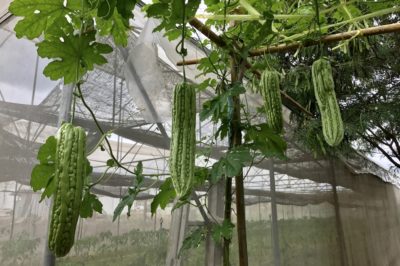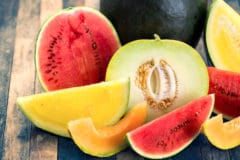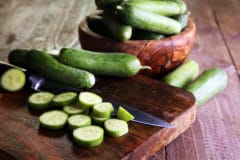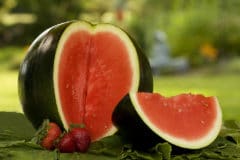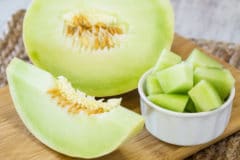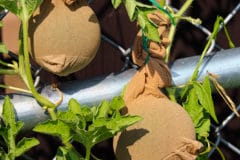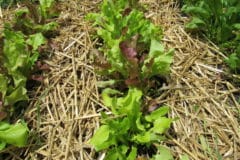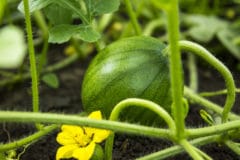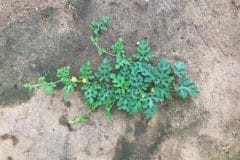Bitter Melon Description
Bitter melons are broken into two types: Chinese and Indian, which are based on each country’s preference. The basic differences between the two varieties include:
- Chinese: Warty appearance, oblong-shaped, smooth ridges and green skin, 8 to 12 inches long.
- Indian: Smaller than Chinese variety, pointy ridges, dark green skin and pointy ends.
The vines grow about 16 feet long and have multiple branches. Alternate and simple leaves are 2 to 5 inches across, and have three to seven deeply separated lobes. Once the vine produces about six leaves, it starts the production of tendrils, which assists the vine in climbing.
About a month after planting, the vine produces small, male and female yellow flowers pollinated by beneficial insects like bees. Male flowers usually remain open for only one day and then fall from the vine.
Expert Tip: Gardeners living in cooler regions can grow bitter melon in a greenhouse. However, flowers will have to be pollinated by hand, which is easy as transferring pollen from one flower to the next using a small paintbrush.
Preferred Growing Conditions
Bitter melon is a warm-season vegetable crop that thrives when conditions are hot and humid. You can start your seeds in peat pots indoors or in a greenhouse several weeks before planting outdoors when temperatures warm. Wait until temperatures reach a minimum of 60°F (15.5°C) to plant the transplants in the garden or direct sow the seeds.
Expert Tip: Bitter melon seeds germinate best with temperatures ranging between 60°F to 95°F (15.5°C to 35°C). Seeds planted at cooler temperatures can fail to germinate.
Best conditions for growth include:
- A site situated in sun for the majority of the day produces the best growth.
- Fertile soil that drains well with a pH of 5.5 to 6.7.
- If growing in a container, plant one plant in a 3- to 5-gallon container with bottom drainage and filled with a rich, well-drained potting mix.
Expert Tip: If your desired planting site’s soil lacks needed nutrients, amend the site with about 6-inches of well-rotted manure or compost, worked about 8 inches into the native soil. Make sure all weeds and grasses are removed from the site, as they rob the plant of needed nutrients and moisture, and can lead to pest and disease problems.
Planting Bitter Melon
If planting bitter melon seeds, plant them about 1 inch deep and space multiple plants about 3 feet apart. Good circulation of air between plants cuts down on potential disease problems. Water the seeds after planting and keep the area moist but not soggy while the seeds germinate. If the soil is too dry the seeds may fail to germinate.
If you started your bitter melon seeds in peat pots to get a head start, bury the pot and plant at the same depth it’s presently growing and don’t plant deeper or it puts undue stress on the plant.
Install Climbing Structure
Bitter melons produce long, vigorous vines so they prefer a structure on which to climb. Since the plant starts producing its tendrils relatively quickly, it’s best to have a structure in place before planting the seeds or transplanting. You can also damage the tender roots, if you install a trellis after the vine starts growing.
If you already have a fence, trellis or arbor installed in your landscape, you can plant the vine or sit the container next to it. Otherwise, install a trellis that is at least 6 feet tall for the vine. Growing the vine on a trellis makes harvesting the fruit easier and cuts down on potential problems like disease and rot.
Expert Tip: Don’t allow the melons to grow directly on the ground or they will rot.
Continued Care
Water the bitter melon vines regularly as you would a cucumber or squash plant. Fertilize with an organic, general-purpose blend like a 20-20-20 about every three weeks. Spread 2 to 3 inches of compost over the planting site two weeks after planting.
Harvesting & Use
Bitter melons have what some describe as a pleasantly bitter taste, but as the melons mature, the bitter taste becomes less. The melons are ready for harvesting anywhere from 40 to 63 days after planting, depending on the variety.
Most people harvest the fruits when they are anywhere from 4 to 8 inches long. The greener the fruit, the more bitterness it will have. As the fruit matures, it changes from green to orange and the inner seeds turn red.
The skin of the bitter melon is edible and when used, the melon is sliced and the seeds are discarded. It’s best to use the melon within several days after picking, as it quickly degrades. Bitter melon is used in stir-fries, stuffed with meat or seafood, used in soups, or steamed and eaten over rice.
